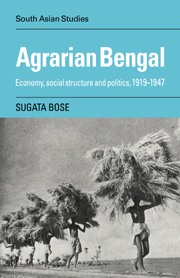Book contents
- Frontmatter
- Contents
- List of maps
- Preface
- List of abbreviations
- PART I AGRARIAN ECONOMY AND SOCIETY: STRUCTURE AND TRENDS
- PART II PEASANTS AND POLITICS
- 6 Agrarian class conflict, nationalism and communalism in east Bengal
- 7 Agrarian relations and mass nationalism in west Bengal
- 8 Sharecroppers' agitations in the frontier regions
- Conclusion
- Glossary
- Select bibliography
- Index
6 - Agrarian class conflict, nationalism and communalism in east Bengal
from PART II - PEASANTS AND POLITICS
Published online by Cambridge University Press: 24 October 2009
- Frontmatter
- Contents
- List of maps
- Preface
- List of abbreviations
- PART I AGRARIAN ECONOMY AND SOCIETY: STRUCTURE AND TRENDS
- PART II PEASANTS AND POLITICS
- 6 Agrarian class conflict, nationalism and communalism in east Bengal
- 7 Agrarian relations and mass nationalism in west Bengal
- 8 Sharecroppers' agitations in the frontier regions
- Conclusion
- Glossary
- Select bibliography
- Index
Summary
Between 1900 and 1930, rural credit was the nub of an interlocking set of relations of production and surplus-appropriation underpinning the agrarian social structure in east Bengal. The peasant smallholding structure could not reproduce itself without being subject to the exploitation of mercantile and usury capital. This unequal, but necessary, symbiosis between smallholding peasants and their trader and talukdar creditors had ruled out the possibility of any sustained conflict. It was only during 1930–47 that conflict between a Muslim peasantry and a predominantly Hindu landed-gentry and small trading community became endemic. The aim of this chapter is to identify the locus of historical initiative behind the forces which led to the disintegration of the plural society in east Bengal.
Agrarian politics will be seen in the context of broad economic trends with particular emphasis on the impact of the 1930s slump on social relations in the countryside. Since the peasantry were not less political than the ‘elite’, a structural analysis and periodisation of their politics is no less important than for the politics of the ‘elite’. Changes in key elements of the agrarian social structure had a decisive influence on the complexion and articulation of peasant politics. With the rupture in rural credit relations in the 1930s, the unequal and symbiotic social networks in east Bengal were torn apart. The talukdar-mahajans and trader-mahajans did not suddenly become more oppressive. In fact, it was during this period that their chief mode of surplus-appropriation through debt interest collapsed.
- Type
- Chapter
- Information
- Agrarian BengalEconomy, Social Structure and Politics, 1919-1947, pp. 181 - 232Publisher: Cambridge University PressPrint publication year: 1987



